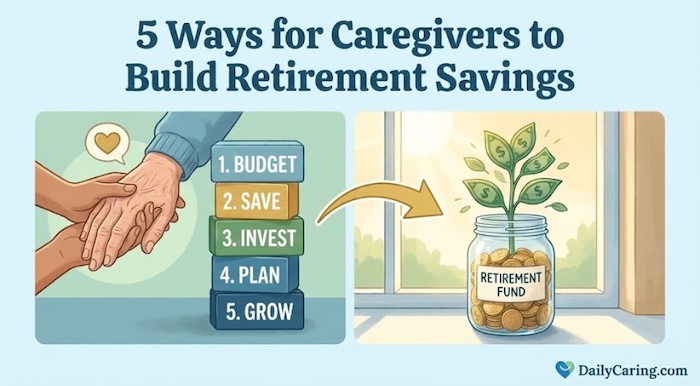Caregiving is a profound act of love and dedication, yet it often entails significant financial sacrifices that can jeopardize your future security. For many caregivers, prioritizing a loved one’s needs means sidelining personal financial goals, including the essential task of building retirement savings.
This article explores practical, accessible strategies designed for those balancing caregiving responsibilities with financial planning. By implementing these actionable steps, you can begin to secure your financial future while continuing to provide compassionate care, ensuring your dedication to others does not come at the expense of your well-being.

When caring for an older adult, it’s easy to set aside your own finances to focus on their needs. To plan for your own future, LendingTree shares five ways to protect your finances and build retirement savings while still supporting them.
Don’t forget about your own financial needs in retirement
According to AARP, approximately 1 in 5 adults in the U.S. provides unpaid family care, either full-time or part-time, to another adult (often a senior parent or relative) or to a child with disabilities.
When caring for loved ones, it can be easy to put aside your financial situation to focus on those who depend on you. However, it’s essential to plan for your own future as well.
Here are five ways you can prioritize your finances and build retirement savings while still supporting those you love.
5 Key Ways to Prioritize Your Finances as a Caregiver
1. Start with a plan
Caring for an aging or ill loved one can be costly and time-consuming for a family caregiver.
For example, when caring for aging parents, it can be easy to forget about your finances altogether or even deplete your savings to pay for their care.
According to a 2020 study by AARP and the National Alliance for Caregiving, 1 in 3 caregivers nearing retirement have used their own savings to fund care, jeopardizing their own long-term financial health.
Creating a budget to understand what you can afford to save for the future is a wise move.
Consider working with a financial advisor who can help you structure your retirement plan and review it regularly.
Caring for an older family member who is struggling financially can also highlight the importance of financial planning. Learn from their experiences to help you plan for your own future.
2. Fund your retirement account
A 65-year-old couple may need about $315,000 in post-tax dollars to cover health care expenses in retirement. This number doesn’t even include long-term care or over-the-counter medication.
That’s a hefty bill to stare down, but making retirement account contributions a priority can help you store funds for the future – with the benefit of compound interest, to boot.
Many retirement accounts also offer tax advantages.
Many employers also match retirement contributions, giving employees access to free money. If you work full-time, make sure you contribute enough to your plan to qualify for the match.
3. Take advantage of all savings opportunities
If you’re a stay-at-home spouse, opening a spousal IRA (if you qualify) is one way to save additional funds for your retirement.
If you’re freelancing or running your own business, keep in mind that individuals who work for themselves can open a Simplified Employee Pension (SEP) plan.
Even if you don’t open a retirement-specific account, starting a savings account and setting aside a small monthly amount can build up cash reserves for unexpected expenses.
Many caregivers must pay out of pocket for unexpected costs that their dependent may not be able to afford.
An ample emergency fund can help you pay these expenses without withdrawing money early from a retirement plan. This is especially helpful because there are often penalty fees for early withdrawals.
4. Seek assistance and benefits programs
It is essential to avoid draining any of your retirement accounts when caring for a family member or friend.
If you care for a loved one, especially if they live in your home, it is a good idea to explore all available assistance options, such as Medicaid, Supplemental Security Income (SSI), or other benefit programs.
Another option is to look for tax breaks.
For example, if your older family member lives with you, you may be able to claim them as a dependent on your tax return.
Caregivers may also qualify for other tax benefits.
5. Make a plan for your own long-term care
Given our longer life expectancy, a long-term care plan is essential.
American men have a life expectancy of 76 years, and women 81 years, according to the CDC.
That’s why a well-constructed retirement plan will take long-term care expenses into account.
A long-term care plan might include insurance that covers care services, such as a home health aide, to help older adults live independently longer.
Making arrangements for your later years, whether setting aside funds to pay for a care community or remodeling your home to allow you to age in place safely, is part of creating a long-term care plan.
Final Thoughts About Retirement Goals for Caregivers
Building retirement savings while caregiving is not about making grand, immediate changes; it’s about taking consistent, manageable steps that align with your unique situation. By taking advantage of catch-up contributions, exploring caregiver compensation programs, and seeking professional financial advice, you can create a sustainable path toward financial security.
Remember, investing in your future is not selfish; it is a necessary component of being a resilient and effective caregiver. Starting today, no matter how modestly, empowers you to care for your loved one without compromising the stability and peace of mind you deserve in the years to come.
Recommended for you:
- Financial Help for Seniors: 2,500+ Federal, State, & Private Benefits Programs
- How to Get Paid by the State for Taking Care of Someone: 3 Benefits Programs
- 4 Financial Assistance Programs for Seniors and Family Caregivers
*This post is for informational purposes only. This post doesn’t constitute financial advice. For financial matters, it’s always best to consult an accredited professional.
Guest contributor: Joseph Muscente is a content analyst at LendingTree, where he helps people make informed financial decisions. He earned his B.A. from Penn State University.













